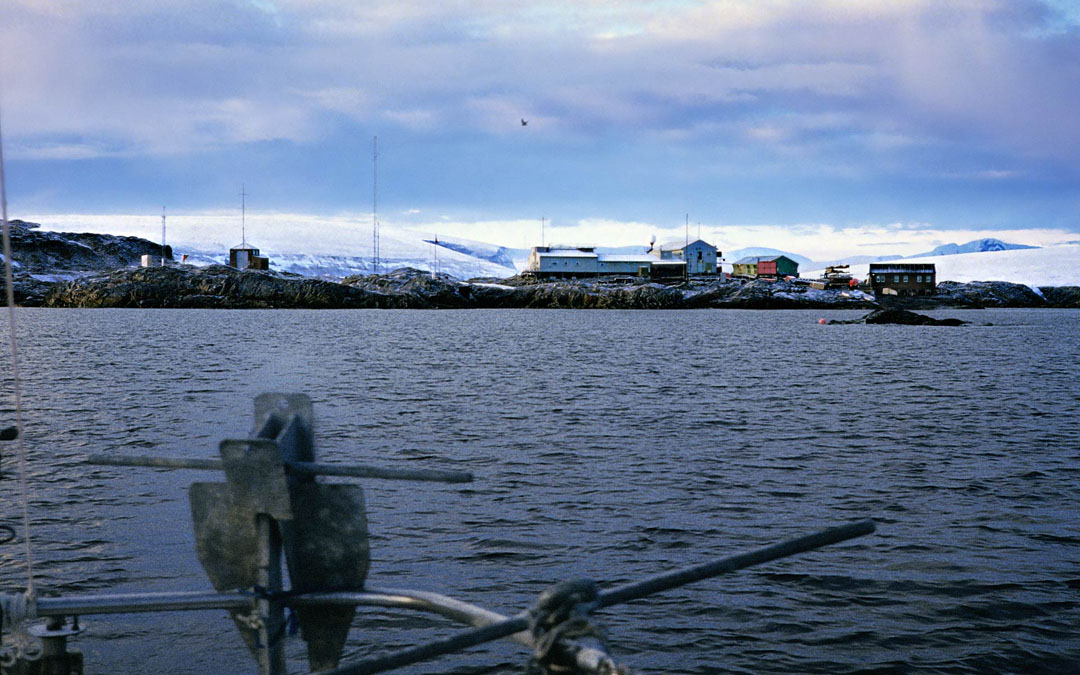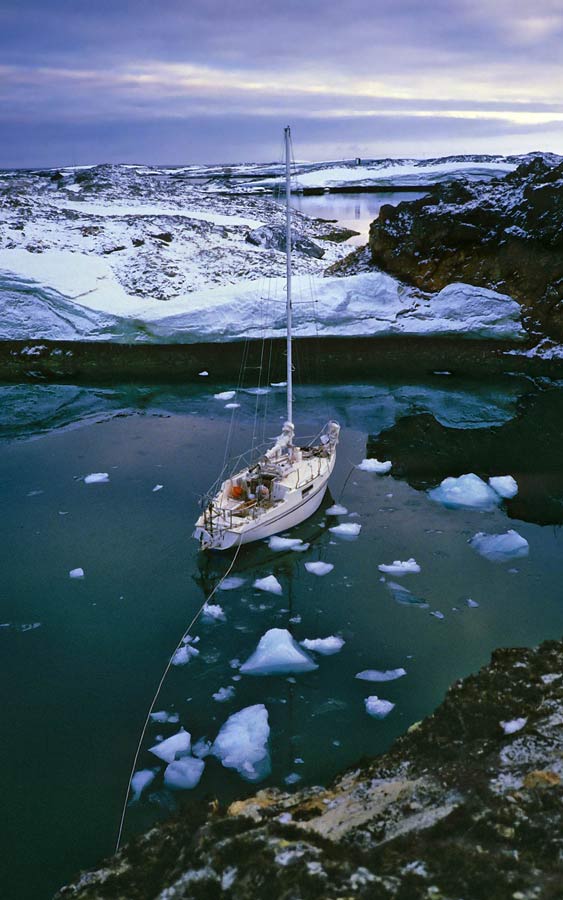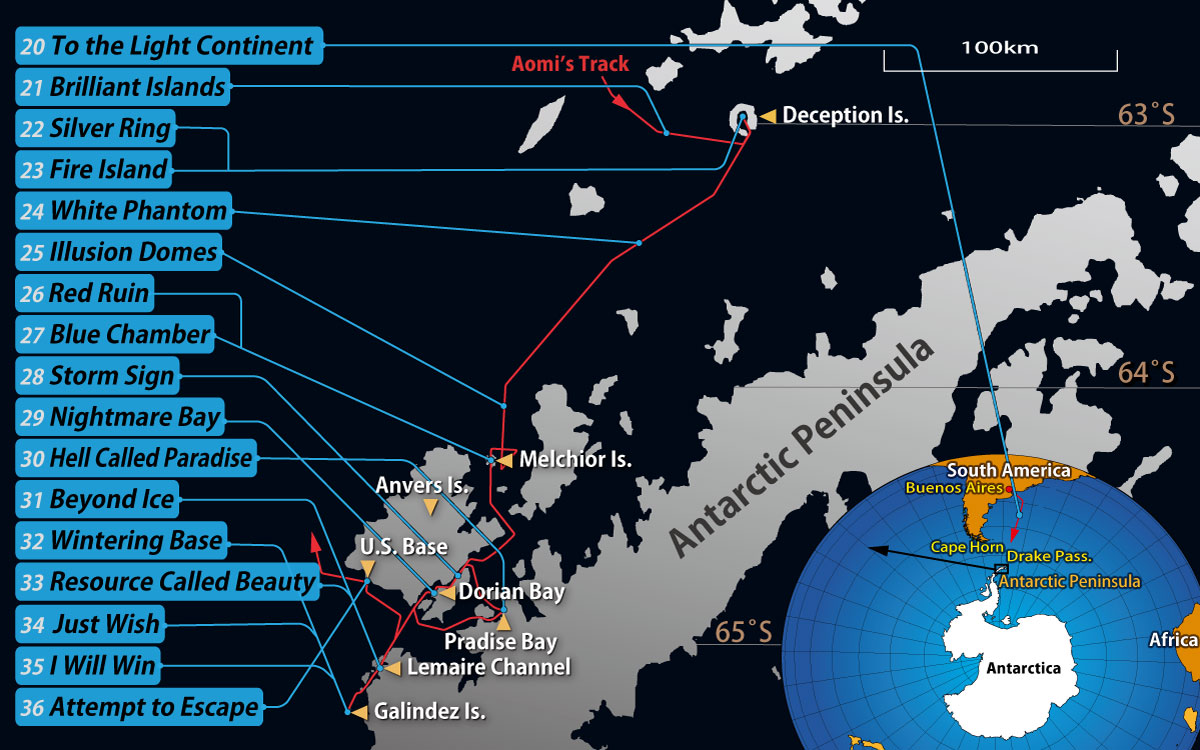32. Wintering Base
 Faraday Station
Faraday Station
A vast expanse of sea opens before me, and I aim my binoculars at the islands on the horizon.
In one corner of my view, I spot Galindez Island, where the antenna towers and buildings of the British Faraday Base stand like miniatures—so faint and so small an existence against the overwhelming grandeur of the Antarctic landscape.
When I reach the cove near the Faraday Base, mentally drained from navigating the icy waters, I collapse onto Aomi's berth and sleep for two whole days.
On March 21, I finally row the dinghy to the base, just 400 meters away. The autumn equinox in the Southern Hemisphere has already passed.
I tie my dinghy to the small wooden dock in front of the base, walk past the roaring power-generator hut, and approach the two-story main building.
At the front entrance, with its thick, freezer-like door, I shed my winter clothes and gloves before heading upstairs to the dining room. There, a man in a red checkered shirt and gray pants greets me. Everyone I see is dressed identically; perhaps it is a uniform.
“Welcome to Faraday Base. How about a cup of tea at the table? We’ve had French sailboats here before.”
“What kind of sailboat?”
“Much bigger than yours, and there were several people on board. But they left during the summer.”
“Why don’t the English boats come? Maybe the French are more adventurous.”
“No, not as much as we British.”
“By the way, how many members do you have here?”
“We have twenty-four members, including scientists, mechanics, and cooks. However, this number will be reduced to less than half, as the wintering period is about to begin.”
After a friendly chat, a cup of Brooke Bond tea, and a tour of the main house, I ask to use the shower.
“Fresh water is precious here, so I hope you’re not wasting it. Why don’t you go back to your yacht and grab some towels and soap?”
“It’s all in my jacket pocket.”
“Oh my goodness! You came prepared, didn’t you?“
The first hot shower in fifty-four days, since leaving Buenos Aires, warms both my frozen body and my weary mind.
A few days later, the supply ship Bransfield arrives to restock the base and withdraw the summer crew, marking the beginning of Faraday Base’s wintering period.
Heading further south is now completely impossible. Worse still, if I do not leave the Antarctic Sea soon, the water will freeze solid, trapping Aomi.
Every day, I try to turn back north, but the snowy post-summer winds block my way. The barometer needle in the cabin swings violently up and down, reading 955 hectopascals, so low you might think it is broken.
Outside Aomi’s tiny windows, the wind suddenly stops blowing, and a blue sky appears briefly between the clouds. But just a few minutes later, a violent blizzard strikes from the opposite direction, revealing that the centers of low-pressure systems pass one after another without a break, as if they refuse to give Aomi any chance to escape the Antarctic region.
Every morning, two alarm clocks ring in the cabin, where the temperature is just 2 degrees Celsius. Although I believe it is time to leave, the weather shows no signs of improving.
Snow continues to pile up on Aomi’s small deck. Real winter will arrive soon, and Aomi and I will be buried beneath snow and ice. Of course, I knew this from the beginning.
After successfully landing on Cape Horn three years ago and navigating the Antarctic waters this time, did I begin to believe that I had the knowledge and skills to sail freely around this beautiful blue planet, Earth?
Did I begin to think that I finally knew the sea?
Did I misunderstand that I could cross any ocean and reach any land on this planet, as long as I was with Aomi?
On the morning of the twelfth day, after arriving at Galindez Island, the thickly overcast sky is ominously dark, but the blizzard and winds I feared have stopped.
Before the next blizzard hits, I’ll pass through the Lemaire Channel again and head about 60 kilometers north.
Weather and luck permitting, I could reach Anvers Island by evening.
No—even if a storm arises, even if I’m unlucky, I’ll somehow make it safely to Anvers Island, just as I have navigated in the past against all obstacles.
From there, I’ll leave the Antarctic coast, sail through the Drake Passage; Aomi should reach Buenos Aires in about a month.


Hi! Any questions or suggestions about the content are greatly appreciated.
I’d also love writing tips from native English speakers. Since English isn’t my first language, if you notice any awkward phrases or anything that seems off, please let me know.
Thank you!
E-mail